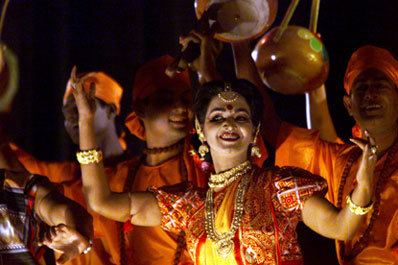 | ||
Religious music HamdNaatGhazalJari ganShreekrishna KirtanaShyama Sangeet Ethnic music Agamani-VijayaBaulBhatialiBhawaiyaDhamailGombhiraKaviganMaimansingha GitikaSari gan Traditional music Rabindra SangeetNazrul GeetiLalonHason Raja Music awards Shilpakala Academy Award Music media RadioRadio FoortiRadio TodayRadio AmarABC RadioTelevisionChannel 9BanglavisionNTVChannel iChannel 16InternetAmaderGaan.com | ||
Kavigan (Bengali: কবিগান) is a form of Bengali folk performance wherein folk poets sing and perform.
Contents
Form
Kavigan is normally sung by two groups. Each group is led by a kaviyal or sarkar. The accompanying singers called dohars often repeat what the leader said. A kavigan programme starts with bandana (evocation) or gurudever geet (song of the sect patron). The bandana can be directed to or be in praise of Saraswati, Ganesh, people, and the audience, as deemed fit by a particular kaviyal. This is followed by Radha–Krishna related song, some call it agamani. Then songs on four subjects are sung: Sakhi sambad, biraha, lahar and kheur.Sakhi Sambad deals with the love-songs related to Radha-Krishna. Biraha is about the mortal pang of separation of common human beings. Kheur is mainly about gods and goddesses, but often includes mild slangs. Finally, the competitive part starts. It mainly consists of the Lahar, where the competitors personally attack each other, musico-verbally. In kavigan, also referred to as kabir larai, two person who are lyricist plus composer at the same time answer each other in form of songs.
History
In his Banglar Kavigan, Sajani Kanta Das said, "Kavigan was born out of a synthesis of various art forms prevalent in different parts of Bengal at different times having peculiar names such as tarja, panchali, kheur, akhrai, half akhrai, full akhrai, danra kavigan, basa kavigan, dhap kirtan, tappa, Krishna jatra, tukkagiti etc." Various literary researchers such as Ishwar Chandra Gupta and Dr. Harekrishna Mukhopadhyay have dwelt at length on the origins and development of kavigan.
Dr. Sushil Kumar Dey opines, "The existence of kabi songs may be traced to the beginning of the 18th century or even beyond it to the 17th; but the flourishing period of the Kabiwalas was between 1760 and 1830." As the religious and ritualistic content in Bengali poetry wore out there was a tendency to break away from the traditional Vaishnava poetry but the real breakthrough came only with the introduction of the printing press in mid–18th century. From the close of the 18th century for more than half a century the new kavi–poetry and panchali reigned supreme in the Kolkata region and almost threatened to sweep everything else in literature. However, while Kavigan lost its supremacy in Kolkata, it retained its position in rural Bengal.
Dr. Sushil Kumar Dey has a word of praise for the kaviyals, "These poets were, no doubt, born among the people (lowest classes), lived with the people and understood perfectly their ways of thinking and feeling; hence their direct hold upon the masses of whom many a modern writer is contentedly ignorant."
Kaviyals
A number of kaviyals attained popularity and fame. In Birbhum district alone there were about three hundred kaviyals from the 18th–20th century. Amongst the earliest were Lokokabi Lambodar Chakroborty, Gonjla Guin, born in the 18th century and his contemporaries: Lalu–Nandalal, Raghu and Ramji. The famous 19th century kaviyals of Kolkata were Haru Thakur, Nitai Vairagi, Ram Basu, Bhola Maira, and Anthony Firinghee.
Some of kaviyals in other parts of Bengal were Balahari Roy (1743–1849), Sambhunath Mondal (1773–1833), Tarakchandra Sarker (1845–1914), Haricharan Acharya (1861–1941), Ramesh Chandra Shil (1877–1967), Rajendranath Sarkar (1892–1974), Bijaykrishna Adhikari (1903–1985), Nishikanto Raysarkar.
Mukunda Das, more popular as a charan kavi, was also a kaviyal. His character was featured in a popular Bengali film Balika Bodhu, wherein the songs of Mukunda Das inspired the rural masses during the independence movement,
Another famous kaviyal, Anthony Firingee, a person of Portuguese origin, was featured in a Bengali biographical film bearing his name, with Uttam Kumar portraying him.
Bhola Moira (19th century) kaviyal was a popular and entertaining singer who could keep his audience mesmerised. Realising the importance of popular entertainment, Ishwar Chandra Vidyasagar complimented Bhola Moira and said, "To awaken the society of Bengal, it is necessary to have orators like Ramgopal Ghosh, amusing men like Hutom Pyancha and folk singers like Bhola Moira". Bhola Moira is a biographical film about him, made in 1977.
